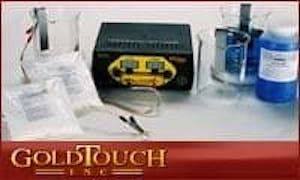world gathers for metal finishing
Q&As since 1989
-----
Cracks in brush plated copper
Q. I got a couple of responses about copper brush plating kits and thought I should get some more info. We have a couple of copper jobs (OFHC copper), which have developed cracks in their electron beam welds. The cracks are about 1 millimeter wide, 1 mm deep and 2-3 mm long. These need to be filled with copper. That implies plating copper on copper. NOT for strengthening purposes. The finish has to be almost mirror finish. In a couple of jobs the cracks are deeper 3-4 mm deep - can brush plating fill deeper cracks? In some cases the cracks are a bit inaccessible - at the end of a 600 mm long, 200 mm dia. cylinder. Any opinions/views and of course quotes (with details) of brush plating kits are welcome.
Dr. Nitin ThakurAustralian National University
1998
A. From the information you have given, I can say that you can brush plate these cracks.With a one to one aspect ratio of the cracks, it makes for a little more difficult repair. First you need to open up the cracks with a small grinder. A Dremel [on eBay or Amazon] tool works fine. You need to do this because you would be using a acid copper solution which does not have very good throwing power. It would have a tendency to bridge over the crack top. After you dished out the crack(at least ten to one)then you can plate. You need to mask off the repair area by approx. 1/16 inch around the crack.After you are finished plating, you must dress back to the original surface. Again you can use the Dremel [on eBay or Amazon] with various attachments to do this. As to a final polish,use the Dremel with a polishing point to polish to the desired final surface finish. There are more questions that need to be answered before I can say what exactly you need to accomplish this. As far as a kit goes, for your application a simple kit would suffice.
Tom Sivulaplating shop - Harbor City, California
1998
March 16, 2013
Q. Hi Readers,
First of all, excuse my English. I speak Spanish, I'm from Argentina.
I'm going to begin in brush plating (I bought the system last year) once I finish my blasting cabinet. The idea is to do industrial repairs.
I've been watching some videos of cylinder repairs, it seems a simple procedure. However there's something I don't understand.
If you have to fill in an imperfection (on any piece) with copper you will inevitably plate copper around the imperfection too (even masking).
So, the question is:
You have to grind the excess of material before plating with the final material?
If yes, how do you do to keep the surface plain?
Thank you,
Eric.
- Buenos Aires, Argentina
A. Hello, Eric
The answer to your question is to mask around the defective area before build-up. One millimeter is generally enough. This way you limit the over plated areas and reduce grinding time. Aluminum adhesive tape is preferred to insulating tapes to allow the current (and the metal) to spread over it and avoid heavy steps. The nickel underplate should be applied without masking well beyond the area you need to fill (6 mm or more). It is very thin and will not interfere with dimensions or operation. It will prevent attack on tape boundaries or under etch if edges lift prematurely. It will help you see when you reach the original surface level when grinding manually, thanks to the distinctive color of nickel as compared to steel or chrome. By the way, your English is very good. Saludos desde Mexico,
Guillermo Marrufo
Monterrey, NL, Mexico
March 20, 2013
adv.
Brush plating equipment, chemicals, and supplies from Gold Touch

Q, A, or Comment on THIS thread -or- Start a NEW Thread
